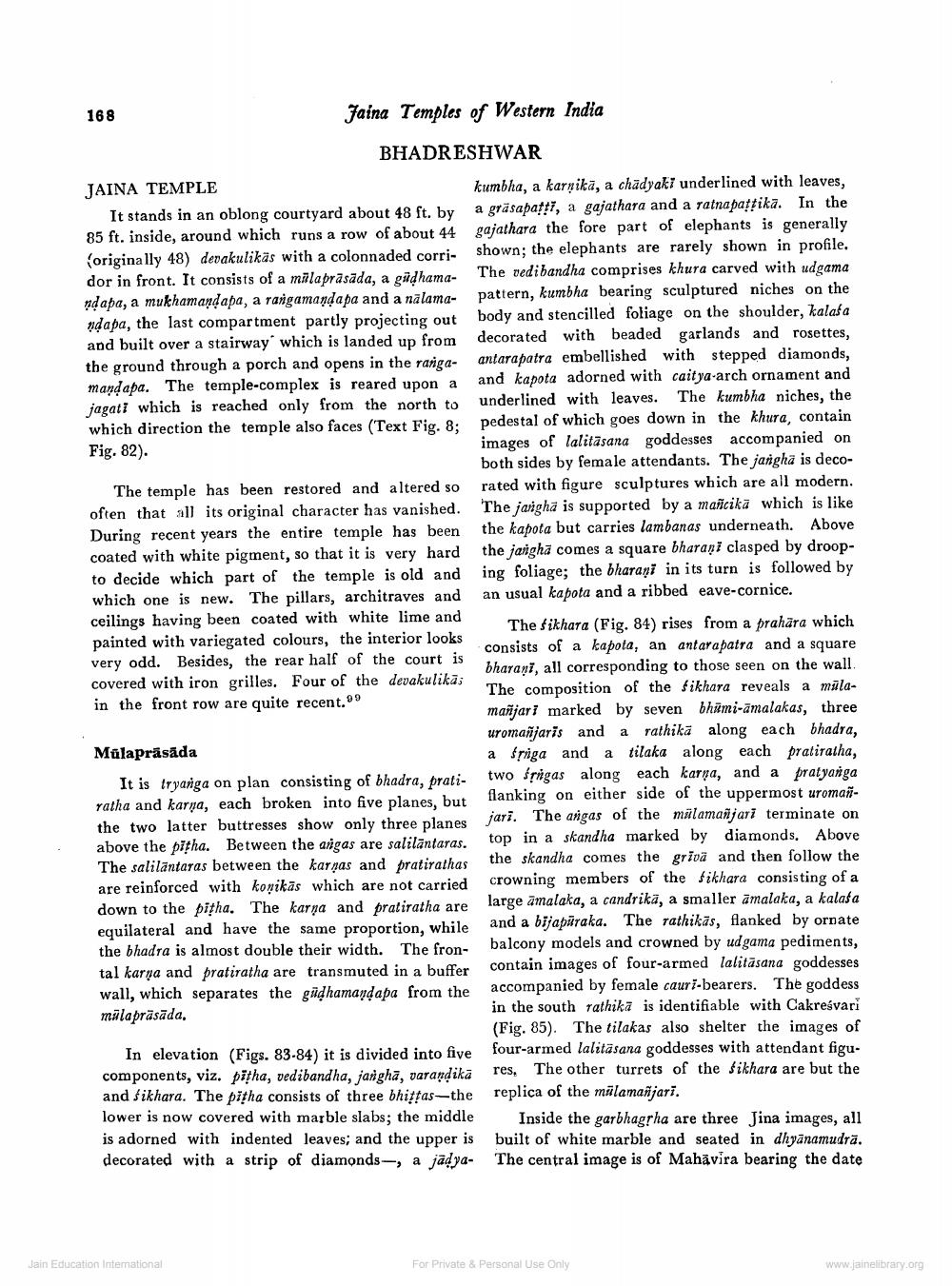________________
168
Jaina Temples of Western India
BHADRESHWAR JAINA TEMPLE
kumbha, a karnika, a chadyaki underlined with leaves, It stands in an oblong courtyard about 48 ft. by a gräsapatti, a gajathara and a ratnapattika. In the 85 ft. inside, around which runs a row of about 44 gajathara the fore part of elephants is generally (originally 48) devakulikäs with a colonnaded corri- shown; the elephants are rarely shown in profile. dor in front. It consists of a milaprāsāda, a půdhama. The vedibandha comprises khura carved with udgama ndapa, a mukhamandapa, a rangamandapa and a nalama- pattern, kumbha bearing sculptured niches on the ndapa, the last compartment partly projecting out body and stencilled foliage on the shoulder, kalaba and built over a stairway which is landed up from decorated with beaded garlands and rosettes, the ground through a porch and opens in the ranga- antarapatra embellished with stepped diamonds, mand apa. The temple-complex is reared upon a and kapota adorned with caitya-arch ornament and jagati which is reached only from the north to underlined with leaves. The kumbha niches, the which direction the temple also faces (Text Fig. 8: pedestal of which goes down in the khura, contain Fig. 82).
images of lalitasana goddesses accompanied on
both sides by female attendants. The jangha is decoThe temple has been restored and altered so rated with figure sculptures which are all modern. often that all its original character has vanished. The jangha is supported by a mañcika which is like During recent years the entire temple has been the kapota but carries lambanas underneath. Above coated with white pigment, so that it is very hard the jangha comes a square bharani clasped by droopto decide which part of the temple is old and ing foliage; the bharani in its turn is followed by which one is new. The pillars, architraves and an usual kapota and a ribbed eave-cornice. ceilings having been coated with white lime and
The Sikhara (Fig. 84) rises from a prahāra which painted with variegated colours, the interior looks very odd. Besides, the rear half of the court is
consists of a kapota, an antarapatra and a square
bharaṇi, all corresponding to those seen on the wall covered with iron grilles. Four of the devakulikās
The composition of the Sikhara reveals a mūlain the front row are quite recent.99
mañjari marked by seven bhimi-āmalakas, three
uromajaris and a rathikā along each bhadra, Müla prāsāda
a Srriga and a tilaka along each pratiratha, It is tryaniga on plan consisting of bhadra, prati- two frigas along each karya, and a pratyanga ratha and karva, each broken into five planes, but flanking on either side of the uppermost uromanthe two latter buttresses show only three planes jari. The angas of the milamasjari terminate on above the pitha. Between the argas are salilantaras. top in a skandha marked by diamonds. Above The saliläntaras between the karnas and pratirathas the skandha comes the griva and then follow the are reinforced with konikās which are not carried crowning members of the fikhara consisting of a down to the pitha. The karna and pratiratha are large amalaka, a candrika, a smaller amalaka, a kalasa equilateral and have the same proportion, while and a bijapäraka. The rathikas, flanked by ornate the bhadra is almost double their width. The fron- balcony models and crowned by udgama pediments, tal karna and pratiratha are transmuted in a buffer contain images of four-armed lalitasana goddesses wall, which separates the endhamandaba from the accompanied by female cauri-bearers. The goddess malaprāsāda.
in the south rathika is identifiable with Cakreśvari
(Fig. 85). The tilakas also shelter the images of In elevation (Figs. 83-84) it is divided into five four-armed lalitāsana goddesses with attendant figucomponents, viz. pitha, vedibandha, jarighā, varandika res, The other turrets of the fikhara are but the and fikhara. The pitha consists of three bhittas-the replica of the malamanjari. lower is now covered with marble slabs; the middle Inside the garbhagrha are three Jina images, all is adorned with indented leaves, and the upper is built of white marble and seated in dhyānamudrā. decorated with a strip of diamonds-, a jadya- The central image is of Mahāvira bearing the date
Jain Education Interational
For Private & Personal Use Only
www.jainelibrary.org




